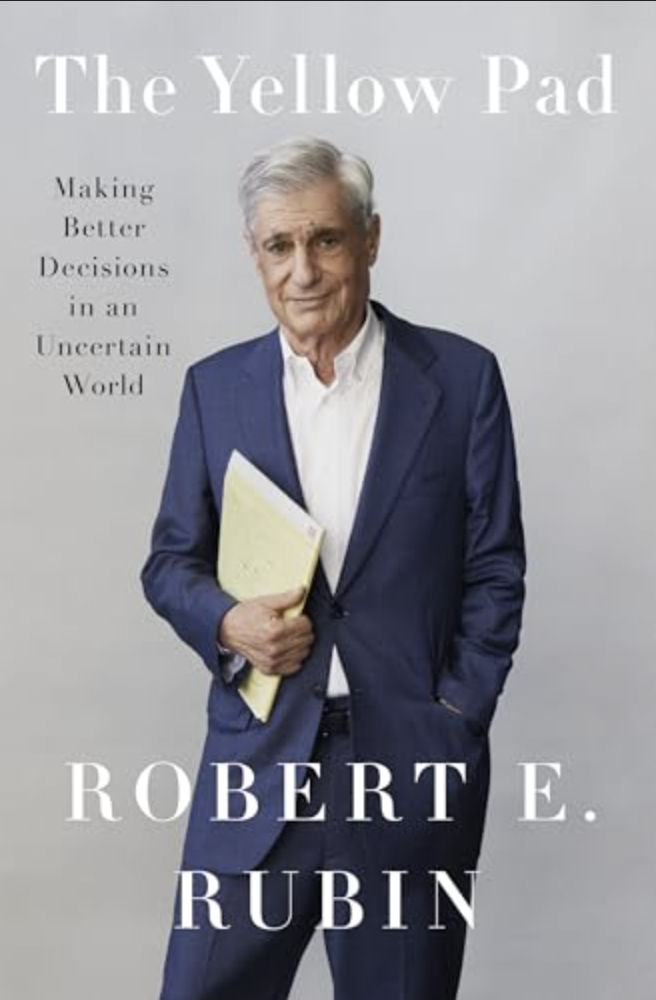Key Quote:
“How will human beings respond to our decisions in the real world? And how is our own human nature likely to affect the decision-making process?” (p. 255).
Key Points and Concepts
Probabilistic Thinking
Decisions are about probabilities. “If nothing is certain, then views can be expressed only in terms of probabilities” (p. xxiv).
Probabilistic thinking requires discipline. Seeking simple solutions and fast answers requires little effort. To contend with complexity is “through conscious effort and through doing” (p. xxv).
Reacting Versus Responding
Rubin met with a group of incarcerated people who determined that their crimes took less than five minutes to commit and led to 715 total years in prison. Reacting instead of thoughtfully responding can be costly (pp. 3-4).
“I have found that what distinguishes strong leaders and good decision makers isn’t that they have no emotional bias. It’s that they understand their emotional biases and compensate for them” (p. 7).
Leaders can challenge their biases by seeking diverse views. But they must use groups to make better calls, not use them to abdicate their own responsibility (p. 12).
Decisions should not address emotional reactions but respond to the challenges at hand. The 1994 crime bill was an attempt to address a real problem that voters cared about. Many of its provisions, such as implementing mandatory minimum sentences and canceling educational opportunities for incarcerated people, only satisfied visceral desires. The law failed to respond to the real challenges at cause and are the result of crime (pp. 16-18).
Risk as a Range
Leaders should avoid the trap of ignoring risk until it becomes measurable. In 2016, Rubin and Hank Paulson visited the SEC to argue that it should require financial institutions to publicly recognize the potential costs of climate change. The chair, Mary Jo White, answered that doing so was impossible because there was no method for calculating those risks (pp. 29-31).
Decision-makers often view risk as binary or in terms of best case, middle case, and worst-case scenarios. They should instead express risk as a range. “For example, rather than projecting that a country’s GDP will grow by 2 percent, you might project an increase of 1.75–2.25 percent. Then, if you need a single number for calculations, you can take the midpoint. This may seem like an unimportant change but using a small range of outcomes rather than a single number acknowledges uncertainty and complexity and will be more accurate” (p. 33).
Don’t risk more than you are willing to lose. “We strengthened a rule for everyone using Goldman Sachs’ capital to make investments: even if you have extremely high confidence that you can’t lose more than X amount on a given position, there’s still a limit to the total size of the position you can take. That way if the loss turns out to be vastly greater than you’ve estimated, it will be painful, but bearable” (p. 38).
Common Traits of Successful Decision-Makers
Intensity (about accomplishing what you’re engaged in): On fishing trips, Hank Paulson wakes up at 6 AM to have the best chance to catch fish. Pursuing success with intensity leads to more focused and exhaustive pursuit of goals, especially in times of turmoil (pp. 59-61).
Mental Toughness (preserving the ability to make sound decisions in stressful situations): This requires balancing judgment and self-confidence. NBA players must believe that their next shot will go in, even if the last one didn’t. But they must exercise good judgment in deciding when to take the next shot. Making a probabilistic decision can support confidence when recommending or defending a course of action; this involves recognizing the possibility of failure. Mental toughness also helps leaders avoid derailing unpopular but sound decisions (pp. 61-65).
Energetic Curiosity (constructive skepticism and the instinct to look under the hood): Asking and pursuing good questions leads to productive conversations and better decisions (pp. 65-67).
Being True to Oneself: It is easier to tell people what they want to hear than to express your own opinions. But failing to be true to oneself prevents good decision-making. There is a balance: when making a contentious argument, express yourself in a way that people are most likely to relate to. “There’s a big difference between saying ‘You’re wrong and here’s why,’ and saying ‘You know, you’ve got some good points, and your view could be right. I happen to think on balance it’s not right in this case, and here are my reasons’” (pp. 69-71).
Embracing Human Complexity
“The idea that understanding individuals is an essential element of management may seem obvious. Yet my impression is that many managers don’t fully embrace human complexity in their decision-making, even when they claim to and perhaps genuinely believe they do. Rather than truly acknowledging each person’s combination of skills, motivations, and personal characteristics, and then considering those traits when dealing with each individual, it seems to me that managers often all back on a set of practices that treat all employees the same way” (p. 85).
Blame: “Some senior people in organizations take credit for successes and divert blame…The best managers do the opposite” (p. 90).
Leaders should not wait for culture to happen. They must decide what they want it to be, and craft it from their own personal values and beliefs (p. 96).
Strategic Dynamism: “Long term strategy can shift and adapt, but core values and principles remain constant” (p. 97).
“Here is the closest thing I have developed to a universal truth about management: While every organization is different, and each will have its own goals and challenges, one similarity they all share is that the individuals within them are endlessly complicated” (p. 105).
Applied Existentialism
Irrational optimism and irrational pessimism pose equal threats to decision-making (p. 113).
Applied existentialism is “…the ability to be fully invested in one’s work while at the same time gaining some remove by recognizing that in a truly cosmic sense, the crisis, and one’s success or failure in addressing it, do not matter.” A degree of remove creates a better environment for decision-making (p. 117).
Keeping perspective when facing scrutiny is essential. Media trainer Michael Sheehan advised Rubin to stick to the message while addressing a reporter’s question: “‘Whatever you say,’ he explained, “connect it to the question. And then segue from there to whatever it is you want to say about wherever it is you want to go.’ In this way, a leader can use interaction with the media to steer the conversation while still engaging seriously with a reporter’s own interests and priorities” (pp. 122-123).
What Do We Learn from What Goes Wrong?
Many leaders and organizations evaluate decisions ex post facto (after the fact), considering only the outcome. But an ex ante (before the fact) approach lends key insight. “Hindsight is twenty-twenty—or to put it in probabilistic terms, if an outcome has already materialized, the probability of it materializing is obviously 100 percent. But equally obviously, the probability was not 100 percent before the outcome occurred. An ex ante approach recognizes that it’s important to consider the odds as they existed before—not after—the event” (p. 131).
Identify assumptions: “Thus, were I advising traders or other position takers at a bank like Citi today, I would— in part because of what I have learned from the 2008 financial crisis—want them to periodically try to identify the assumptions, both large and small, that they might not realize they were making. Most of these assumptions would probably prove uncontroversial. But having a list might, in some cases, allow them to recognize that what appears to be a virtually certain truth is in fact a high-probability outcome that includes a tail risk” (p. 150).
Open Exchange of Views
Assume the best in people: “If you start with a presumption that others are acting in good faith and are confident that the same presumption is being extended to you, you are far more likely to say what you really think and to be open to others saying what they really think as well” (p. 162).
Avoid searching for blame: “Even when organizations are willing to evaluate the quality of past decisions (including those made by senior leaders) using rigorous analysis, they too often focus on figuring out who to blame. That’s generally counterproductive, because once people know management is looking for a scapegoat, they may engage in self-preservation rather than self-evaluation” (p. 163).
“Good challengers” are people who ask disruptive questions or express contrary views in a productive way. The way their disposition enhances decision-making usually outweighs any interpersonal strife that inviting them in may cause (pp. 168-170).
Not Everything is the Alamo
Searching for compromise is almost always worth the trade-off. Inviolable principles stand in the way of productive compromise, especially in public institutions. Taking a firm stand on principles is rarely worth the cost of inaction, and so should be the exception and not the rule (pp. 177-200).
“The preponderance of the time, probabilistic thinking and an expected value-mindset allow for the nuance and complexity that the bright-line approach lacks” (p. 201).
A Well-Run Policy-Making Process
1. Define clear objectives and goals (p. 211).
2. Adopt the right approach to working with experts (among whom consensus is rarely in place) (pp. 211-212).
3. Timing is crucial: ask if you must make the decision now. And if not, consider what will help make it later (p. 213).
4. Apply a cost-benefit analysis to policy options, even when unquantifiable factors are in play. Avoid talking only about benefits, but costs as well (pp. 214-215).
5. Recognize the possibility that all the likely outcomes are bad (including inaction) (pp. 215-216).
Foundational Questions
Before making a major decision, identify any foundational questions you must ask. Rubin recalls participating in a policy group discussing how to grow economies and provide better social services in cities. Taking the time to stop and consider what constitutes a city helped them design more effective policy (pp. 233-235).
“Finally, I believe that considering foundational questions makes one a more effective advocate. Let’s say that I knew I was about to meet with a high-ranking official from a country with a poor human rights record, and that the subject of human rights was likely to come up. If I were a moral absolutist, my arguments in favor of respecting human rights would, no matter, how profoundly expressed, become largely circular: ‘We should respect human rights because it’s important to respect human rights’” (p. 241).
The Human Factor
Decision-makers must ask themselves, “How will human beings respond to our decisions in the real world? And how is our own human nature likely to affect the decision-making process?” (p. 255).
“The best way to deal with the human tendency to think in binaries is to address that tendency in the decision-making process. If individuals come across a yes-or-no question, they should ask if it might be more productive to ask a sliding-scale question instead” (p. 270).
Rubin, R.E. (2023). The Yellow Pad: Making Better Decisions in an Uncertain World. New York: Penguin Press.

“How will human beings respond to our decisions in the real world? And how is our own human nature likely to affect the decision-making process?”
“I have found that what distinguishes strong leaders and good decision makers isn’t that they have no emotional bias. It’s that they understand their emotional biases and compensate for them.”
“Here is the closest thing I have developed to a universal truth about management: While every organization is different, and each will have its own goals and challenges, one similarity they all share is that the individuals within them are endlessly complicated.”
Assume the best in people: “If you start with a presumption that others are acting in good faith and are confident that the same presumption is being extended to you, you are far more likely to say what you really think and to be open to others saying what they really think as well.”
